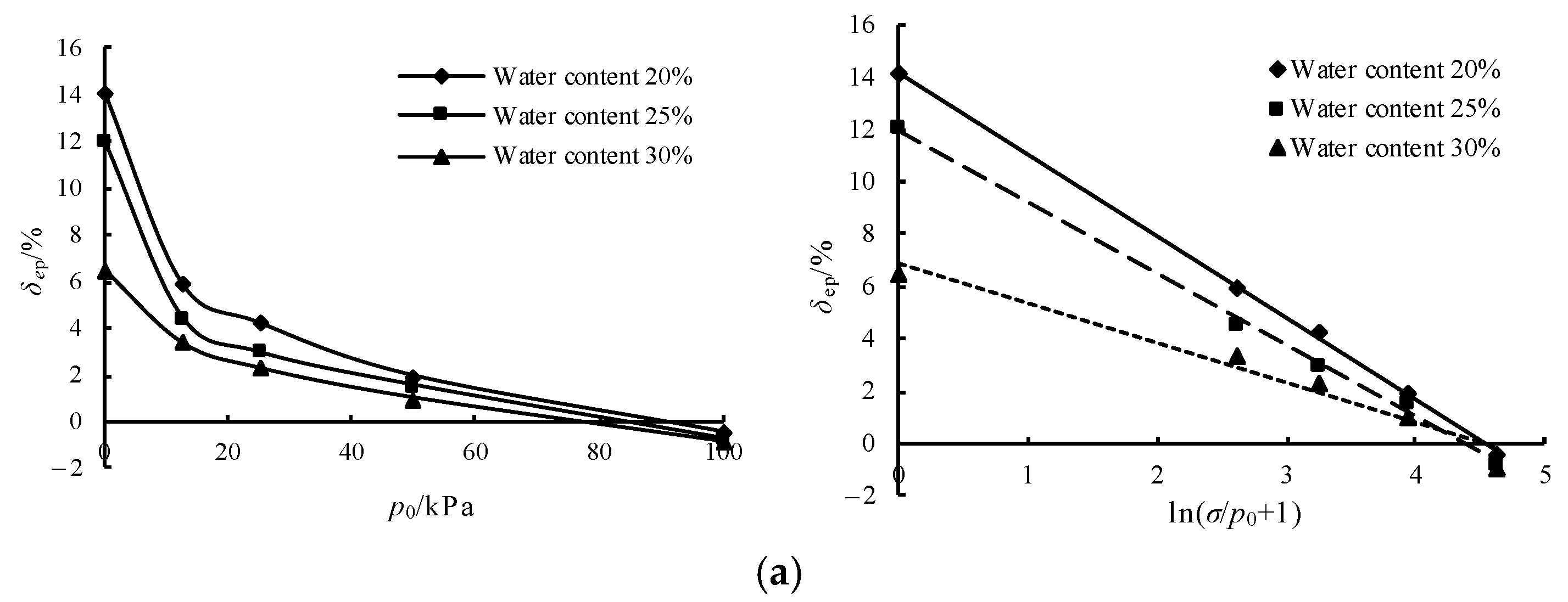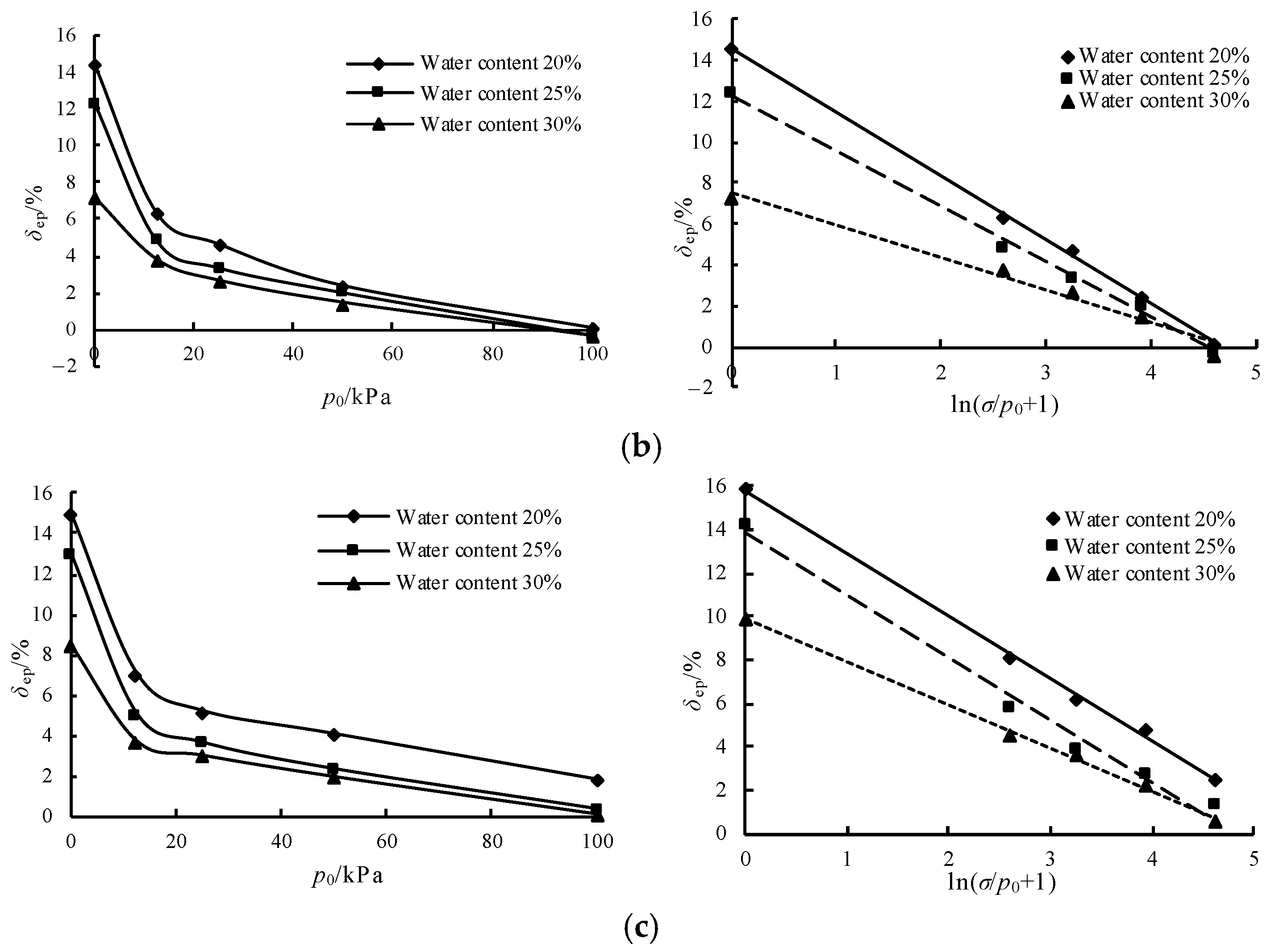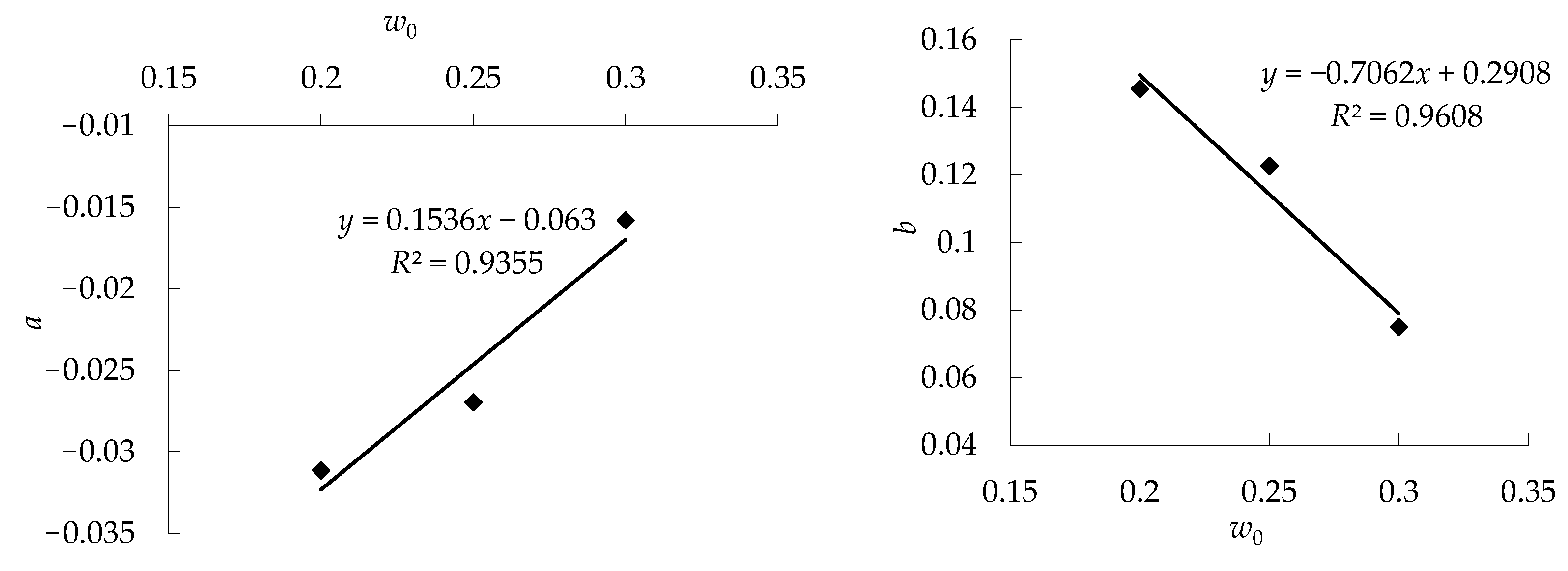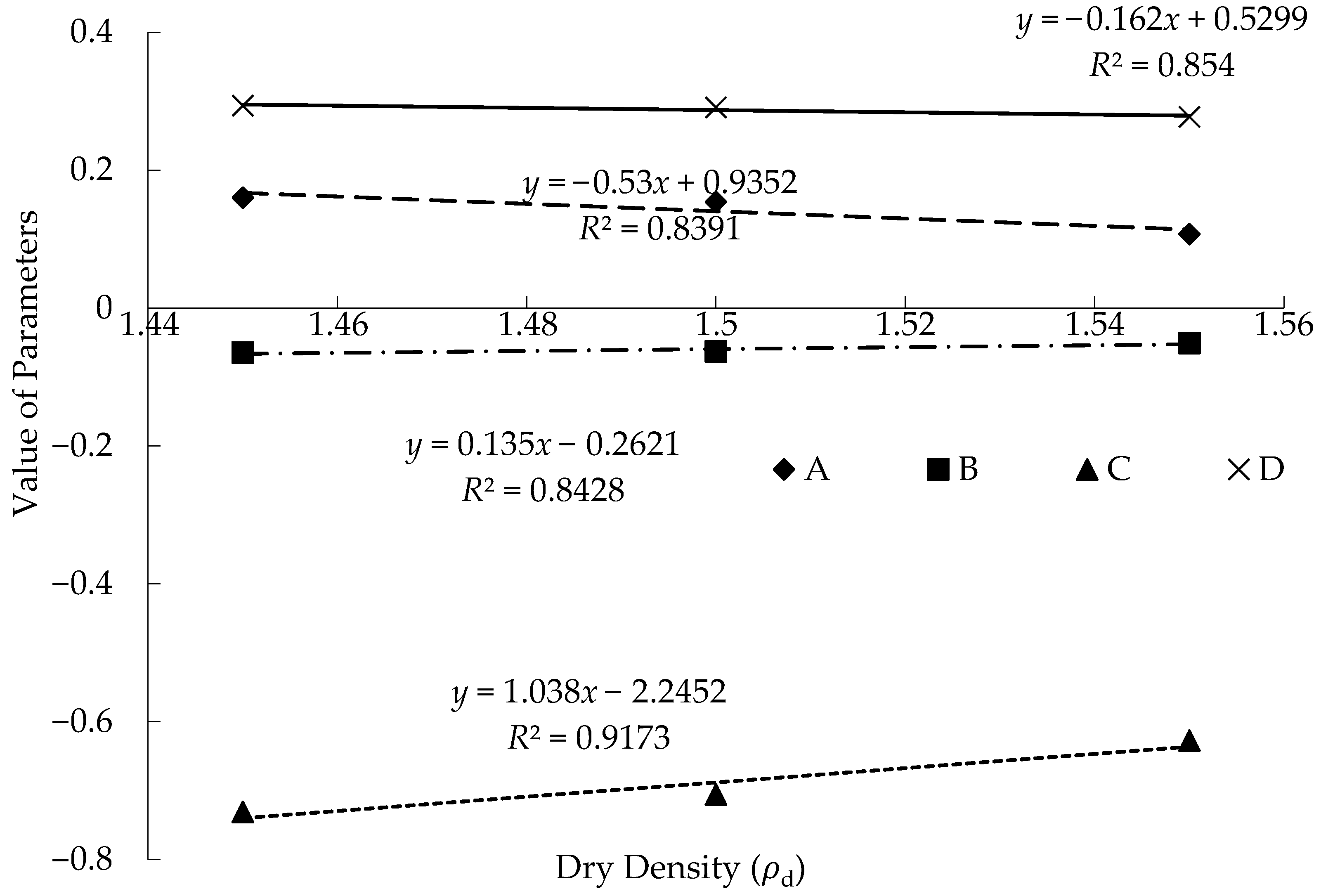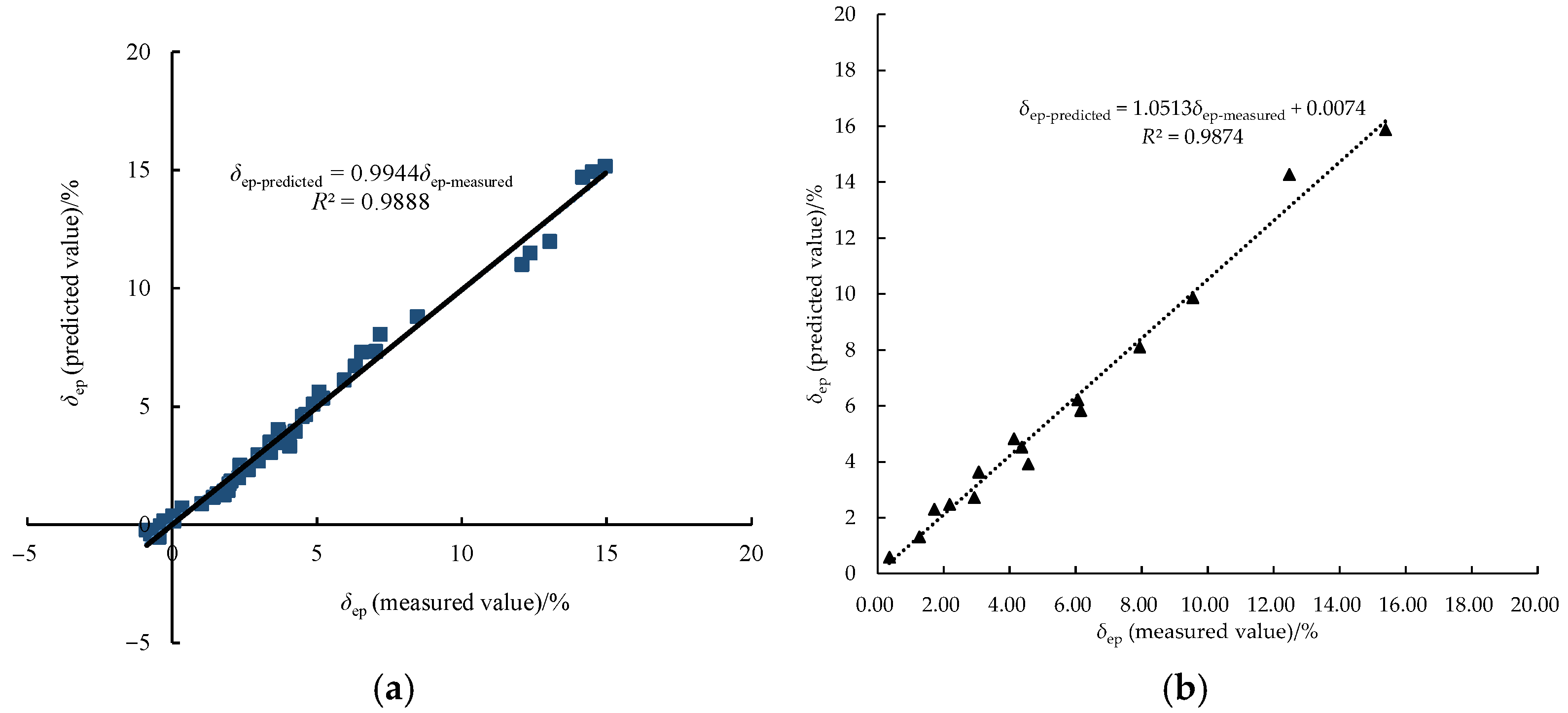1. Introduction
Expansive soils are a type of clay that undergo significant swelling upon water absorption and shrinkage upon drying [
1,
2,
3,
4]. These soils are widely distributed in arid and semi-arid regions and present significant challenges for construction, particularly in terms of foundation stability and long-term structural performance [
5,
6,
7,
8,
9,
10]. A defining feature of expansive soils is their high content of hydrophilic clay minerals, such as montmorillonite, which undergo considerable volume changes in response to moisture variation [
11,
12,
13,
14]. This behavior can compromise the integrity of built infrastructure by causing foundation settlement, structural cracking, and deformation of underlying soils [
15,
16,
17,
18].
Expansive soils are typically classified by their swelling potential, with strong expansive soils exhibiting particularly pronounced swelling and shrinkage behavior [
1,
2,
19,
20]. Such soils are highly susceptible to engineering problems under variable environmental and stress conditions and have become a key subject of research in geotechnical and foundation engineering [
1,
2,
21,
22]. The swelling behavior of strong expansive soils is influenced not only by their mineral composition, particle structure, and moisture content, but also by external stress states. One such condition is the K
0 state, which corresponds to zero lateral strain and is commonly encountered in geotechnical applications such as retaining wall backfills, subgrades, and shallow foundations. However, limited research has quantitatively examined the response of expansive soils to these constrained stress paths, especially for strong expansive clays. Moreover, the interaction between lateral confinement and volumetric expansion under realistic field conditions has been largely overlooked in previous studies [
23,
24,
25].
Existing studies on expansive soils have significant advanced the understanding of their swelling mechanisms under free swelling and partially confined conditions [
1,
2,
19,
23,
26,
27,
28,
29,
30,
31]. Numerous empirical and semi-empirical models have been developed based on laboratory tests conducted under zero lateral stress [
26,
27,
28] or isotropic loading conditions [
29,
30], with some studies also examining the effect of suction and moisture content [
31]. However, the swelling behavior of strong expansive soils under K
0 stress conditions remains insufficiently investigated, particularly with respect to the quantitative relationships between swelling rate, dry density, overburden pressure, and initial water content. Moreover, most existing models are derived from tests on weak to moderately expansive soils, resulting in a gap in both theoretical development and practical applicability for strongly expansive soils under constrained stress paths relevant to building foundation engineering [
24,
25].
Expansive soils are widely used in hydraulic infrastructure such as canal linings, earth dams, and foundation backfills. However, the stability of these structures and adjacent buildings is highly vulnerable to moisture-induced volume changes. In particular, strong expansive soils, which are characterized by high montmorillonite content, can generate swelling pressures sufficient to crack concrete linings, lift embankments, or compromise building foundations. Documented cases in large-scale water conservancy and construction projects have shown that uncontrolled soil expansion often leads to hydraulic leakage, shortened service life, and even structural failure. This underscores a critical engineering need for accurate prediction models under field-representative stress conditions, such as K
0 states, to support both hydraulic and foundation design. While swelling-related problems have been observed in major projects [
21,
22], predictive tools suitable for constrained stress environments remain scarce. The absence of transferable models continues to limit effective design mitigation strategies in expansive soil regions.
Despite these advances, most existing models are limited to free-swelling or isotropically loaded conditions and do not capture the constrained, anisotropic environments commonly encountered in shallow foundations and canal linings. In addition, prior studies often emphasize weak to moderately expansive soils, neglecting the more severe behavior exhibited by strong expansive soils under realistic stress paths such as the K0 condition.
To address these limitations, this study proposes a semi-logarithmic swelling rate model for strong expansive soils under K0 stress conditions. The model incorporates dry density, initial water content, and overburden pressure within a unified predictive framework. Compared with previous models, it provides three key improvements: (1) stress responsiveness adapted to constrained field conditions, (2) parameter trends that support generalization across compaction and moisture ranges, and (3) a closed-form expression suitable for practical design applications.
The proposed model is based on laboratory tests performed on strong expansive soil sampled from the South-to-North Water Diversion Middle Route Project. The experimental results were used to calibrate and validate the model through regression analysis. This approach offers both theoretical insight into expansive soil behavior and practical value for swelling control in dams, canals, and foundation engineering.
2. Materials and Test Procedures
The swelling experiments were performed using a custom-designed lever-type consolidation apparatus (Jianhua Soil Instrument Co., Ltd., Nanjing, China). This device applies vertical stress through a mechanical balance arm and counterweight system, allowing precise control and stable loading over extended periods. It features a rigid steel consolidation chamber that prevents lateral deformation, ensuring one-dimensional vertical swelling comparable to field conditions observed in compacted backfills and canal beds.
The soil used in this study was sampled from the canal bed of the Nanyang Section II of the South-to-North Water Diversion Middle Route Project. It was classified as a strong expansive soil with a free swelling ratio of 112%, determined according to the Chinese Standard SL237-1999 [
32] for expansive soil identification. X-ray diffraction (XRD) analysis with Cu-Kα radiation was conducted using a D8 Advance diffractometer (Bruker AXS GmbH, Karlsruhe, Germany), which confirmed a high content of montmorillonite in the mineral composition.
Prior to testing, the soil was air-dried, crushed, and passed through a 2 mm mesh to remove large particles and organic matter. Specimens were prepared by static compaction in cylindrical steel molds to achieve target dry densities of 1.45, 1.50, and 1.55 g/cm3. Each compacted sample was sealed in plastic and stored for 24 h to ensure uniform moisture distribution. Initial water contents of 20%, 25%, and 30% were selected to simulate typical field variations caused by rainfall or construction scheduling. The chosen dry densities correspond to field compaction levels typically achieved using standard or modified Proctor energy, while the selected moisture contents reflect common ranges observed in expansive soil zones affected by seasonal infiltration and engineering practice.
To simulate the K0 stress condition, which is defined by zero lateral strain, a rigid-wall oedometer apparatus was used. This setup prevented lateral deformation and applied only vertical loading. Vertical pressures of 0, 12.5, 25, 50, and 100 kPa were applied to represent stress levels commonly encountered in dam cores and canal beds, corresponding to shallow soil depths up to approximately 8 m. The rigid lateral boundaries ensured zero horizontal strain throughout the test, thereby reproducing in situ constraints. These loading levels were selected to represent working stress conditions in shallow earth structures and to capture both free swelling (0 kPa) and confined swelling behavior under increasing pressure.
Swelling was measured by monitoring the vertical displacement of the specimen during water infiltration. Water was introduced from the bottom through a porous stone to minimize surface disturbance and reduce the risk of local cracking or uneven swelling. The swelling rate was calculated as
where
h0 and
h are the initial and final specimen heights (in cm), respectively, and
h −
h0 is the height increment (in cm).
All tests were conducted in accordance with ASTM D4546-14 [
33]. Each configuration was tested once using a freshly prepared specimen. Given the irreversible structural changes that occur in expansive soils after swelling, conventional repetition under identical conditions was considered scientifically inappropriate. Previous studies have demonstrated that even nominally identical specimens may exhibit considerable variability due to inherent heterogeneity, which can obscure consistent parameter trends. Therefore, a single test was performed per condition under strictly standardized procedures, including uniform sample preparation, compaction, and moisture conditioning.
All specimens were prepared from the same undisturbed soil profile to ensure material consistency. In total, 45 datasets were obtained across various combinations of dry density, initial water content, and overburden pressure.
The experiment design aimed to replicate the stress and moisture boundary conditions typically encountered in hydraulic earth structures. This setup enabled a controlled investigation of expansive soils behavior under confinement, providing a basis for developing accurate prediction models.
3. Characteristics and Variation in Swelling Rates
The swelling rates of strong expansive soil under varying dry densities, initial water contents, and overburden pressures are summarized in
Table 1. Corresponding trends for each dry density level (1.45, 1.50, and 1.55 g/cm
3) are illustrated in
Figure 1. These results demonstrate the coupled influence of soil compactness, moisture condition, and external pressure in controlling swelling behavior.
At an overburden pressure of 100 kPa, some swelling rates become slightly negative, indicating that the applied vertical stress suppresses the soil’s natural tendency to swell and induces slight compression. At this loading level, the external stress exceeds the internal swelling pressure generated during wetting, resulting in a net reduction in specimen height.
3.1. Effect of Overburden Pressure
For each fixed dry density and water content, the swelling rate (δep) decreases with increasing overburden pressure, reflecting the inhibitory effect of external loading on vertical expansion. At lower pressure levels (e.g., 0–12.5 kPa), the reduction is sharp, indicating that even minimal confinement significantly restricts free swelling. At higher pressures (e.g., 50–100 kPa), the rate of reduction becomes more gradual. In some cases, particularly at low dry density and high water content, the swelling rate becomes negative under 100 kPa, indicating net compression or shrinkage. This threshold behavior suggests that the applied vertical stress exceeds the internal swelling pressure of the soil.
This phenomenon can be attributed to the stress equilibrium between the expansion force generated by hydrated clay minerals and the external confining load. When the applied stress surpasses the intrinsic swelling pressure, the soil structure compresses, often accompanied by inter-particle pore collapse and microstructure rearrangement. This is particularly important in engineered structures where design pressures may fluctuate due to changes in water level or load redistribution.
From an engineering perspective, the overburden stress in earth dam cores and canal foundations, primarily caused by self-weight and hydraulic head, typically ranges from 20 to 100 kPa. Understanding how swelling is suppressed under increasing pressure is essential for assessing whether the soil will exhibit expansion or consolidation in these buried zones. When the applied stress exceeds the intrinsic swelling pressure, structural stability is enhanced. Conversely, if the stress is insufficient, upward deformation may occur and must be mitigated. To address this, engineers may adopt preloading or implement staged compaction to ensure that the applied pressure surpasses the critical swelling threshold.
3.2. Effect of Initial Water Content
At a constant dry density, increasing the initial water content leads to lower swelling rates. This is because a significant portion of the clay minerals’ swelling potential has already been activated under moist conditions. As water content rises, matric suction decreases and the mineral layers approach saturation, leaving limited capacity for further expansion upon wetting. This effect is most evident in the 30% water content group, where swelling remains minimal across all pressure levels.
This behavior illustrates the coupling between unsaturated soil suction and the hydration of expansive clay minerals. When water content is low, the soil exhibits high suction, which draws water into the interlayer spaces of clay minerals and results in more pronounced expansion. In contrast, higher initial water content reduces suction gradients, thereby lowering the driving force for swelling.
From an engineering perspective, pre-wetting the core material in dam construction can help mitigate future swelling risks. By adjusting the initial water content to near-saturation levels, post-construction volumetric instability can be reduced. However, excessive wetting should be avoided to prevent softening and strength loss. Field implementation requires balancing swelling suppression with the need to maintain sufficient strength and compaction quality.
3.3. Effect of Dry Density
For a given water content, increasing the dry density leads to a notable rise in swelling rate. This counterintuitive result occurs because higher dry density increases the total amount of expansive minerals per unit volume. Moreover, the compacted soil has a more constrained internal structure, which intensifies the buildup of swelling pressure during hydration. As a result, the expansion force acts more effectively against the surrounding confinement. This explains why specimens with 1.55 g/cm3 exhibit greater swelling than those with 1.45 g/cm3 under comparable test conditions.
From a microstructural perspective, higher dry density corresponds to lower initial porosity and a reduced void ratio. When water infiltrates, expansive minerals swell within a confined pore space, generating greater internal stress and producing more pronounced macroscopic deformation. The combination of material density and mineral activity leads to an amplified expansion response.
From a practical standpoint, this finding highlights an important trade-off in hydraulic earthworks. Although higher dry density improves shear strength and reduces permeability, it can also elevate swelling potential in expansive soil. Therefore, density control should be integrated with other treatments such as chemical stabilization or moisture adjustment. Additives like lime or fly ash may help suppress swelling while preserving strength or durability. Construction specifications should clearly define compaction targets that account for the soil’s expansive behavior.
4. Development of the K0 Swelling Model for Strong Expansive Soils
Experimental results showed that the linear swelling rate (
δep) of strong expansive soils under K
0 stress conditions decreases with increasing overburden pressure. This relationship generally follows a logarithmic trend, particularly when dry density and initial water content are held constant. As shown in
Figure 1, each dry density group exhibits a consistent decrease in swelling rate with increasing pressure, with variations influenced by moisture content.
However, directly applying the logarithmic function becomes problematic at zero pressure because ln(0) is undefined. To address this, a small constant (1 kPa) was added to all pressure values, resulting in a modified term ln(1 + σ/p0), where p0 = 1 kPa. This adjustment ensures a continuous and valid function across the entire pressure range, including the unloaded case (σ = 0).
Using this formulation, the test data were analyzed to establish a functional relationship between swelling rate and pressure. For each group of specimens with fixed dry density and water content, the swelling rate was plotted against ln(1 + σ/p0), and strong linear trends were observed.
Based on these observations, a semi-empirical model was proposed:
where
a and
b are fitting parameters dependent on both the initial water content (
w0) and dry density (
ρd). A two-stage fitting procedure was adopted. In the first stage, parameters were fitted separately for each fixed dry density. In the second stage, generalization across all densities was performed. Details of the fitting process are presented below.
The parameter a represents the sensitivity of swelling to external stress. A larger absolute value of a indicates a stronger response of the swelling rate to pressure changes. This behavior is typically observed in specimens with lower dry density or lower initial water content. In contrast, b characterizes the intrinsic swelling potential at zero or near-zero confinement. It reflects the combined effects of structural porosity and initial hydration and serves as an overall indicator of swelling tendency.
It is also worth noting that at higher water contents, the slope parameter a decreases in magnitude. This suggests that as soils approach saturation, their ability to respond to stress differentials weakens due to limited suction gradients and reduced hydration capacity. This behavior is consistent with the concept of “saturation buffering”, where excess pore water absorbs load without significant expansion.
This interpretation aligns with field observations, where pre-wetted expansive soils generally exhibit more stable swelling behavior under variable loading conditions.
4.1. Parameter Fitting for Each Dry Density
Regression analysis was performed to quantify the relationship between swelling rate and overburden pressure under various initial conditions. For each dry density (ρd = 1.45, 1.50, 1.55 g/cm3), swelling rate data corresponding to three initial water contents (20%, 25%, and 30%) were fitted using the semi-logarithmic model defined in Equation (2). The resulting coefficients a and b were subsequently analyzed to evaluate their dependence on initial moisture content.
Table 2 summarizes the fitted regression coefficients for each initial water content. These values form the basis for examining whether linear relationships exist between the coefficients and
w0.
Figure 2 illustrates how the coefficients
a and
b change with
w0.
Although both parameters decrease approximately linearly with increasing water content, their trends differ in implication. Specifically, while a remains negative, its absolute value becomes smaller, indicating that the soil’s sensitivity to overburden pressure decreases as it becomes wetter.
The fitted relationships are:
Substituting Equations (3) and (4) into (2), gives the swelling rate model for
ρd = 1.45 g/cm
3:
Table 3 presents the fitted coefficients at
ρd = 1.50 g/cm
3. Compared with the previous case, the regression remains strong across all water contents.
To further examine how the regression coefficients respond to changes in moisture, the values of
a and
b for
ρd = 1.50 g/cm
3 are plotted against initial water content in
Figure 3.
The figure shows that both coefficients exhibit approximately linear trends with respect to w0. Specifically, a becomes less negative as w0 increases, indicating that the pressure-suppressing effect on swelling diminishes with higher moisture. Meanwhile, b, which corresponds to the free swelling component, also declines, suggesting a lower baseline expansion capacity in wetter soils.
The corresponding regression Equations are:
The model for
ρd = 1.50 g/cm
3 is therefore expressed as follows:
Table 4 lists the fitted regression coefficients for
ρd = 1.55 g/cm
3 under three levels of initial water content. These values are used to investigate the correlation between the model parameters and moisture conditions.
To visualize these dependencies,
Figure 4 plots the values of
a and
b against the corresponding initial water contents.
As in previous cases, both parameters exhibit near-linear trends across the moisture range. The trend indicates that the absolute value of a decreases as w0 increases, suggesting reduced pressure sensitivity in wetter soils. Similarly, b, which corresponds to the maximum swelling potential under zero load, also shows a declining trend. Compared to lower-density conditions, these trends are more gradual, implying that the influence of moisture content on swelling behavior diminishes with increased compaction.
The linear regressions reveal the following relationships:
Substituting (9) and (10) into the general model formula (2), the swelling rate model for
ρd = 1.55 g/cm
3 becomes:
The fitted Equations (5), (8) and (11) capture the swelling behavior of strong expansive soil under various combinations of dry density and initial water content. Across all three dry densities, parameter a remains negative but becomes progressively less negative with increasing w0. This consistent reduction in absolute magnitude suggests that the swelling rate becomes less sensitive to overburden pressure as the initial water content increases. Parameter b, which reflects the theoretical free swelling potential, also decreases with w0, indicating reduced expansion capacity under wetter conditions.
These findings demonstrate that higher dry density reduces both the free swelling potential and the sensitivity to overburden pressure, highlighting the critical role of compaction in swelling mitigation.
It is noted that the regression analyses between swelling parameters (a and b) and initial water content (w0) within each dry density group are based on only three moisture levels. While the observed linear trends are physically interpretable and show strong correlation (R2 > 0.96), the limited number of data points may restrict the statistical robustness of the fitted relationships. Future studies will include additional water content intervals to enhance the reliability of regression fitting and improve the generalizability of the parameter trends.
4.2. Generalized Swelling Model
To develop a unified swelling model that accounts for the combined effects of dry density (ρ
d) and initial water content (
w0), the regression parameters
a and
b from Equations (5), (8) and (11) were further analyzed. These parameters, initially fitted under different ρ
d values in
Section 4.1, follow a consistent linear form with respect to
w0. By comparing the trends across all dry densities, a generalized expression was formulated to describe the swelling rate (
δep) as a function of overburden pressure (
σ), water content, and density.
where
A,
B,
C, and
D are empirical coefficients that vary with dry density ρ
d. According to the fitted models in Equations (5), (8) and (11), the regression parameters
A,
B,
C, and
D for each ρ
d are summarized in
Table 5.
Each of the four coefficients exhibits a nearly linear relationship with dry density, as visualized in
Figure 5.
The fitted lines show clear trends that can be expressed using first-order polynomials.
These trends provide the basis for the following regression expressions:
Substituting Equations (13)–(16) into Equation (12), and further into Equation (2), yields the final expression for the swelling rate under K
0 stress conditions, which becomes:
This equation provides a continuous and explicit formulation of the linear swelling rate δep as a function of three fundamental geotechnical parameters: dry density ρd, initial water content w0, and overburden pressure σ. Dry density reflects the level of soil compaction and influences particle arrangement within the soil mass. Initial water content captures the pre-wetting state of the material, which is often affected by environmental exposure or construction timing. Overburden pressure represents the combined effect of soil self-weight and any external loading such as embankments, structural foundations, or surcharge from stored water.
Unlike traditional empirical charts or discrete lookup tables, this model allows for the direct, quantitative prediction of swelling behavior across a wide range of field conditions. It can be readily applied in design calculations, parametric sensitivity analyses, and long-term deformation control strategies in hydraulic structures such as earth dams, canal linings, and levees constructed in expansive soil regions. The continuous nature of the model eliminates the need for interpolation and enhances computational efficiency in engineering simulations.
In practice, this formulation enables engineers to estimate swelling potential under various combinations of compaction effort and applied loads, supporting the optimization of material preparation and placement during construction. By simulating how different water contents influence swelling response, the model also facilitates the adjustment of moisture conditioning procedures to minimize post-construction instability. Furthermore, it offers a sound theoretical basis for integration into numerical modeling frameworks, including finite element analyses that account for unsaturated soil behavior and time-dependent boundary conditions.
The model’s structure also offers flexibility for future enhancement. With Its clear parameter dependencies, it can be extended to incorporate additional environmental or material-related variables such as temperature, matric suction, or chemical stabilization effects. This potential for further development makes it a robust and adaptable tool for managing the risks associated with expansive soils in diverse geotechnical settings.
4.3. Validation of the Model
To evaluate the predictive performance of the proposed unified swelling model expressed in Equation (17), a comparison was conducted between the predicted and experimentally measured linear swelling rates across all 45 test cases. Each prediction was obtained by inputting the known values of dry density (ρ
d), initial water content (
w0), and overburden pressure (
σ). The results are shown in
Figure 6, which includes both the in-sample fitting and an independent validation.
Figure 6a presents a scatter plot comparing predicted and measured values for the 45 calibration samples. The data points closely align with the 1:1 reference line, with a coefficient of determination R
2 = 0.9888 and a regression slope of 0.99446, indicating excellent agreement and minimal systematic bias. This confirms that the model effectively captures the swelling behavior across varying compaction and loading conditions.
To further test the model’s robustness, an independent validation was conducted using new data from soil compacted at a dry density of 1.60 g/cm
3, which was not included in the original calibration. The validation set consisted of 15 swelling rate measurements across three initial water contents and five overburden pressures. As shown in
Figure 6b, the predicted values again align well with the measured data, yielding
R2 = 0.981 and RMSE = 0.606%. These results confirm that the model retains high predictive accuracy under previously unseen conditions.
The strong performance in both the calibration and validation datasets demonstrates that the proposed model is not only statistically robust but also practically applicable to real-world geotechnical scenarios involving strong expansive soils. This level of predictive precision is critical for engineering design, especially in earth and hydraulic structures where swelling-induced deformation can lead to cracking, uplift, or long-term serviceability issues. By enabling an early-stage evaluation of the volumetric deformation risk using standard geotechnical parameters, the model supports informed decisions on compaction targets, moisture conditioning strategies, and material selection. Furthermore, its closed-form expression and minimal input requirements allow for seamless integration into spreadsheet tools, design workflows, and finite element platforms, facilitating efficient prediction and mitigation of swelling-related hazards in both design and construction stages.
However, it is acknowledged that all current validations are based on controlled laboratory conditions using a specific type of strong expansive soil from one geographic region. The proposed model (Equation (17)) was developed under K0 loading conditions and calibrated using a limited set of dry densities and initial moisture contents. Therefore, caution is advised when applying it to other soil types, loading paths, or environmental settings. To improve generalizability and field relevance, future work will include in situ monitoring and model recalibration using expansive soils from different geological origins and under diverse engineering conditions.
5. Conclusions
This study examined the swelling behavior of strong expansive soils under K0 stress conditions using a lever-type consolidation apparatus. The test materials came from the canal bed of Section II of the Nanyang Segment in the South-to-North Water Diversion Middle Route Project, where highly expansive clay layers are present. A total of 45 test groups were conducted, covering different dry densities, initial water contents, and overburden pressures.
The results showed that overburden pressure had the greatest influence on swelling. When dry density and moisture content were constant, an increase in pressure significantly reduced the swelling rate, especially at low stress levels. At high pressures, the swelling rate tended to stabilize or even turn negative, indicating that the applied stress had exceeded the internal swelling force of the soil.
Initial water content also played an important role. At the same density, specimens with higher initial moisture had lower swelling rates. This was due to reduced suction and partial activation of the clay minerals before soaking. These results suggest that moisture control is an effective way to reduce post-construction swelling.
Dry density showed a different pattern. At constant water content, increasing dry density led to a higher swelling rate. This is because denser samples contain more expansive minerals per unit volume and create stronger internal forces when confined. The interaction between particles in compacted soil makes the expansion more pronounced when water is absorbed.
To describe these effects more clearly, a swelling model was developed. The model uses a semi-logarithmic formula based on dry density, water content, and overburden pressure. It was able to fit the test data well, with a determination coefficient of R2 = 0.9888. The model captures the nonlinear trend between swelling and pressure while keeping the structure simple and easy to use.
From an engineering perspective, this model is useful for predicting deformation in canal beds, dam cores, and other structures built on expansive soils. The required input parameters are easy to measure in the lab or field. The formula can be built into spreadsheets, charts, or numerical tools for routine use.
Future work will focus on enhancing the model’s applicability and real-world deployment. Firstly, additional laboratory tests will be conducted using expansive soils from different geological regions to verify generalizability across diverse mineralogical and environmental conditions. Secondly, time-dependent deformation mechanisms will be addressed through cyclic wetting-drying and long-term creep tests. Thirdly, the model will be integrated into finite element analysis (FEA) frameworks to simulate swelling-induced displacements in canal beds and shallow foundations. Calibration using in situ monitoring data from active projects will support validation under real-world conditions. Fourthly, to improve statistical robustness, repeat trials under controlled settings will assess measurement variability. Metrics such as standard deviation and coefficient of variation will be used to quantify uncertainty for key swelling parameters. Finally, the model will be extended to account for spatial variability through geostatistical analysis and site-specific calibration. The effects of construction methods, including compaction energy, layer placement, and moisture conditioning protocols, will also be investigated to improve alignment with field practices.
